Phrase structure: organize words into nested constituents.
Context-Free Grammars
context-free grammars (CFGs)
- start with words, words are given a category (part of speech = POS):

- words combine into phrases with categories like NP(noun phrase) and PP(prep.phrase):

- Phrases can combine into bigger phrases recursively:

⇒ forms a tree structure:

Dependency Structure
Different from CFGs, instead of having concepts of NP/PP/etc, dependency structure shows which word depend on which other word.

Prepositional Phrase Attachment Ambiguity
example of ambiguties:

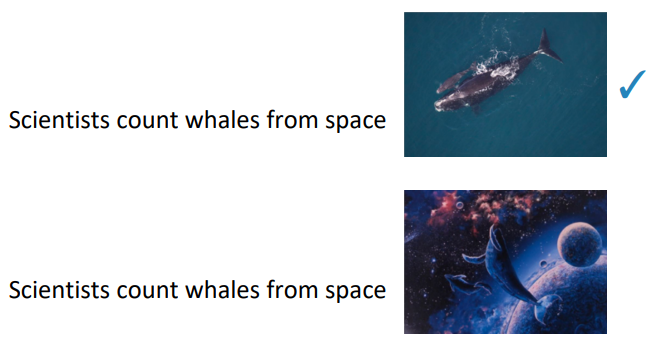
multiplied ambiguities: many PPs in a row

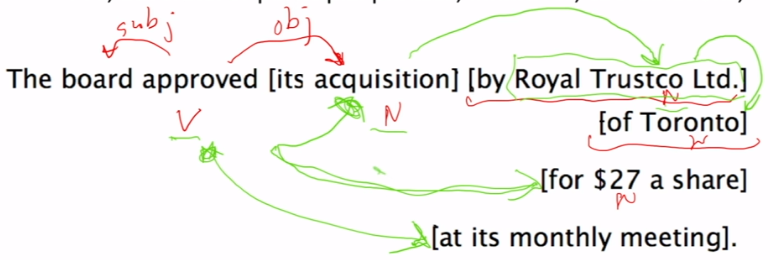
⇒ exp number of possible dep trees,

Dependency Grammar - Structure and Parsing
- Dependency syntax: syntactic structure consists of relations between lexical items, normally binary asymmetric relations (“arrows”) called dependencies.
- The arrows are commonly typed with the name of grammatical relations (subject, prepositional object, apposition, etc.)
- Usually, dependencies form a tree (connected, acyclic, single-rooted graph)
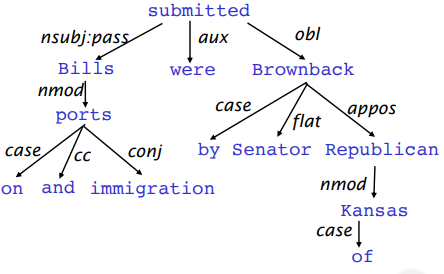
Treebanks
Universal Dependencies treebanks: human-annotated dep trees
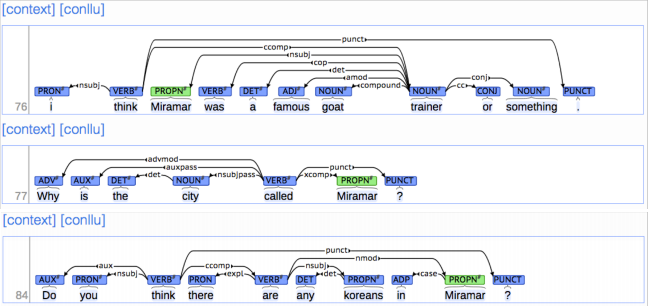
treebank vs.grammar:
- cons:
- slow
- pros:
- Reusability of the labor
- Broad coverage, not just a few intuitions
- Frequencies and distributional information
- A way to evaluate systems
More on Dependency Parsing
Dep parsing: A sentence is parsed by choosing for each word what other word (including ROOT) is it a dependent of. constraints:
- Only one word is a dependent of
ROOT - no cycle
pb: whether arrows can cross (non-projective)

Transition-based Dependency Parsing
greedy discriminative dependency parser, a seq of bottom up actions.
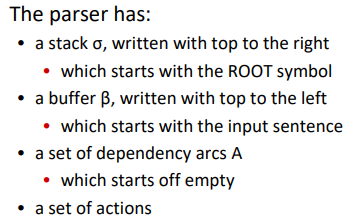
States:
- stack
alpha - buffer
beta - dependencies
A
Possible actions:
SHIFT: removes the first word from the buffer and pushes it onto the stack.LEFT-ARC: marks the second (second most recently added) item on the stack as a dependent of
the first item and removes the second item from the stack.
RIGHT-ARC: marks the first (most recently added) item on the stack as a dependent of the second
item and removes the first item from the stack.
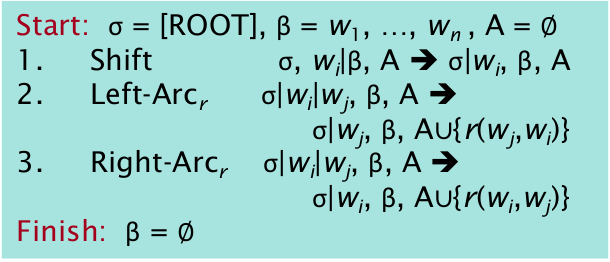
Example:
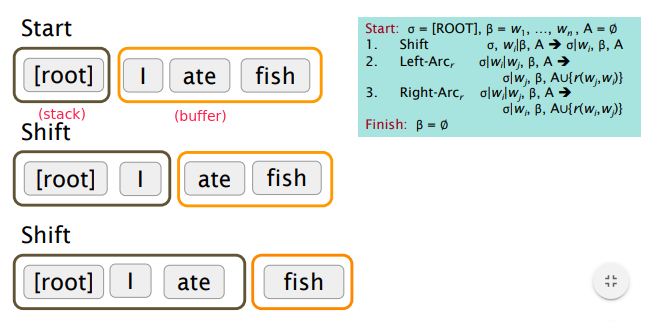
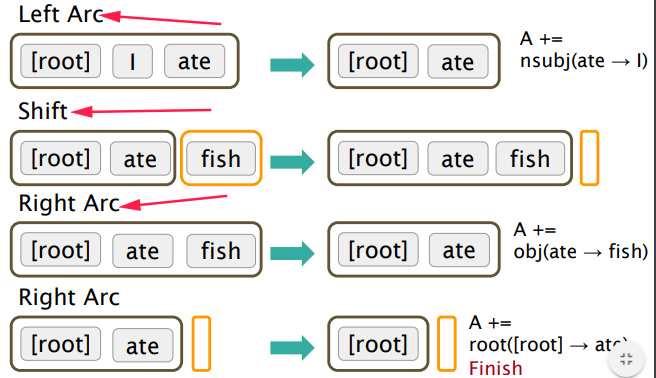
Pb: how to choose the actions (shift/left-arc/right-arc) ? searching all possible actions or DP → cubical complexity❌️ ⇒ use ML to predict actions✔️
- classes: 3 actions (for untyped choices)
- features: stack word, buffer word, POS
- can also do beam search: keep k good parse prefixes at each time step.
⇒ provides very fast linear time parsing, with great performance QUESTION: what creteria to select best path?
Conventional features: hand-engineered, binary (indicator) features
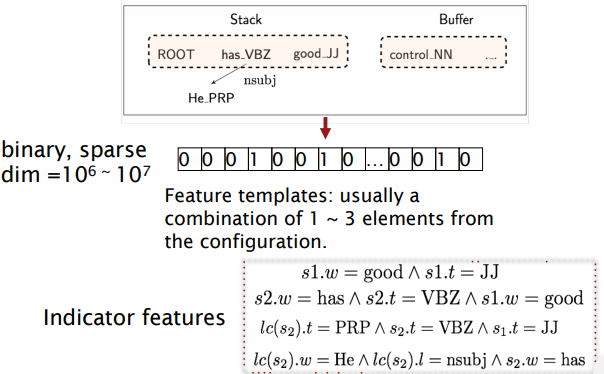
(from assignement) Four types of parsing errors:
- Prepositional Phrase Attachment Error:
e.g. wrong: Moscow sent [troops into Afghanistan] right: Moscow sent [troops] [into Afghanistan] ⇒ prep phrase="into Afghanistan", correct head word = "sent", wrong head word = "troops"
- Verb Phrase Attachment Error
e.g.[Leaving the store unattended], I went outside to watch the parade ⇒ verb phrase = "Leaving the store unattended", head word="went"
- Modifier Attachment Error
e.g.I am [extremely] short ⇒ modifier="extremely", head word="short"
- Coordination Attachment Error
e.g.Would you like brown rice or garlic naan? ⇒ conjuncts="rown rice" and "garlic naan", coordinating conjunction="or" The second conjunct (here "garlic naan") should be attached to the first conjunct (here "brown rice").
Evaluation of Dependency Parsing
eval metrics: dependecy accuracy
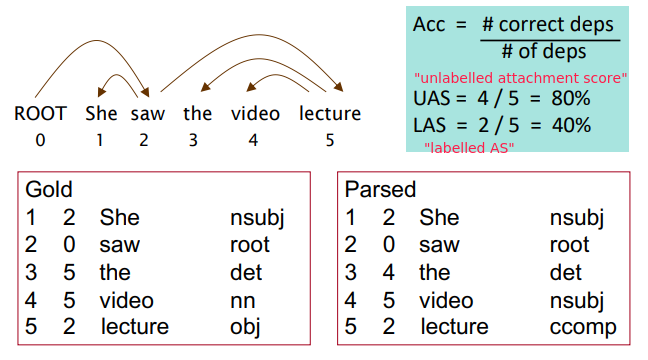
Neural Dependency Parsing
problem with indicator features:
- sparse
- incomplete
- expensive computation: most time are wasted computing the features
⇒ neural dependency parser
- represent each word as a
d-dimensional dense vector (word vectors) - POS and dependency labels are also represented as dense vectors
- rational: some POS tags are similar,
- e.g. NNS(plural nouns) is similar to NN(singular noun), NUM(numbers) similar to AMOD(adj. modifier).
⇒ concat the embeddings of features, feed into a feed forward NN:
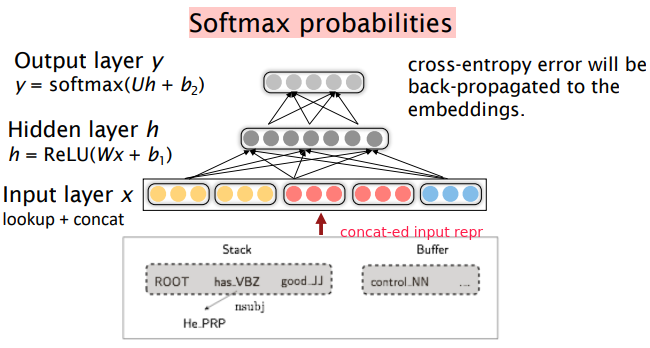
⇒ The dense representations let it outperform other greedy parsers in both accuracy and speed
Part 5 of series «XCS224N: NLP with deep learning»:
- [XCS224N] Lecture 1 – Introduction and Word Vectors
- [XCS224N] Lecture 2 – Word Vectors and Word Senses
- [XCS224N] Lecture 3 – Neural Networks
- [XCS224N] Lecture 4 – Backpropagation
- [XCS224N] Lecture 5 – Dependency Parsing
- [XCS224N] Lecture 6 – Language Models and RNNs
- [XCS224N] Lecture 7 – Vanishing Gradients and Fancy RNNs
- [XCS224N] Lecture 8 – Translation, Seq2Seq, Attention
Disqus 留言